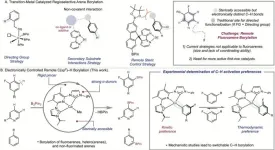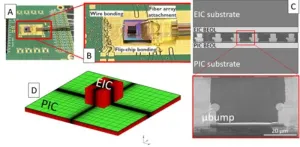(Press-News.org) The Chirik Group at the Princeton Department of Chemistry is chipping away at one of the great challenges of metal-catalyzed C–H functionalization with a new method that uses a cobalt catalyst to differentiate between bonds in fluoroarenes, functionalizing them based on their intrinsic electronic properties.
In a paper published this week in Science, researchers show they are able to bypass the need for steric control and directing groups to induce cobalt-catalyzed borylation that is meta-selective.
The lab’s research showcases an innovative approach driven by deep insights into organometallic chemistry that have been at the heart of its mission for over a decade. In this case, the Chirik Lab drilled down into how transition metals break C–H bonds, uncovering a method that could have vast implications for the synthesis of medicines, natural products, and materials.
And their method is fast – comparable in speed to those that rely on iridium.
The research is outlined in “Kinetic and Thermodynamic Control of C(sp2)–H Activation Enable Site-Selective Borylation,” by lead author Jose Roque, a former postdoc in the Chirik Group; postdoc Alex Shimozono; and P.I. Paul Chirik, the Edwards S. Sanford Professor of Chemistry and former lab members Tyler Pabst, Gabriele Hierlmeier, and Paul Peterson.
‘Really fast, really selective’
“Chemists have been saying for decades, let’s turn synthetic chemistry on its head and make the C–H bond a reactive part of the molecule. That would be incredibly important for drug discovery for the pharmaceutical industry, or for making materials,” said Chirik.
“One of the ways we do this is called C–H borylation, in which you turn the C–H bond into something else, into a carbon–boron bond. Turning C–H to C–B is a gateway to great chemistry.”
Benzene rings are highly represented motifs in medicinal chemistry. However, chemists rely on traditional approaches to functionalize them. The Chirik Group develops new methods that access less-explored routes.
“Imagine you have a benzene ring and it has one substituent on it,” Chikik added. “The site next to it is called ortho, the one next to that is called meta, and the one opposite is called para. The meta C–H bond is the hardest one to do selectively. That’s what Jose has done here with a cobalt catalyst, and no one’s done it before.
“He’s made a cobalt catalyst that is really fast and really selective.”
Roque, now an assistant professor in Princeton’s Department of Chemistry, said rational design was at the heart of their solution.
“We started to get a glimpse of the high activity for C–H activation early during our stoichiometric studies,” said Roque. “The catalyst was rapidly activating the C–H bonds of aromatic solvents at room temperature. In order to isolate the catalyst, we had to avoid handling the catalyst in aromatic solvents,” he added. “We designed an electronically rich but sterically accessible pincer ligand that we posited—based on some previous insights from our lab as well as some fundamental organometallic principles—would lead to a more active catalyst.
“And it has.”
Chirik Lab Target Since 2014
State-of-the-art borylation uses iridium as a catalyst for sterically driven C–H functionalization. It is highly reactive, and it is fast. But if you have a molecule with many C–H bonds, iridium catalysts fail to selectively functionalize the desired bond.
As a result, pharmaceutical companies have appealed for an alternative with more selectivity. And they’ve sought it among first-row transition metals like cobalt and iron, which are less expensive and more sustainable than iridium.
Since their first paper on C–H borylation in 2014, the Chirik Lab has articulated the concept of electronically controlled C–H activation as one answer to this challenge. Their idea is to differentiate between C–H bonds based on electronic properties in order to functionalize them. These properties are reflected in the metal-carbon bond strength. With the catalyst designed in this research, chemists can hit the selected bond and only the selected bond by tapping into these disparate strengths.
But they uncovered another result that makes their method advantageous: the site selectivity can be switched by exploiting the kinetic or thermodynamic preferences of C–H activation. This selectivity switch can be accomplished by choosing one reagent over another, a process that is as streamlined as it is cost-effective.
“Site-selective meta-to-fluorine functionalization was a huge challenge. We made some great progress toward that with this research and expanded the chemistry to include other substrate classes beyond fluoroarenes,” said Roque. “But as a function of studying first-row metals, we also found out, hey, we can switch the selectivity.”
Added Chirik: “To me, this is a huge concept in C–H functionalization. Now we can look at metal-carbon bond strengths and predict where things are going to go. This opens a whole new opportunity. We’re going to be able to do things that iridium doesn’t do.”
Shimozono came to the project late in the game, after Roque had already discovered the pivotal catalyst. His role will deepen in the coming months as he seeks new advances in borylation.
“Jose’s catalyst is groundbreaking. Usually, a completely different catalyst is required in order to change site-selectivity,” said Shimozono. “Counter to this dogma, Jose demonstrated that using B2Pin2 as the boron source affords meta selective chemistry, while using HBPin as the boron source gives ortho selective borylation using the same iPrACNCCo catalyst.
“In general, the more methods we have to install groups in specific sites in molecules, the better. This gives pharmaceutical chemists more tools to make and discover medications more efficiently.”
END
Human noroviruses cause acute gastroenteritis, a global health problem for which there are no vaccines or antiviral drugs. Although most healthy patients recover completely from the infection, norovirus can be life-threatening in infants, the elderly and people with underlying diseases. Estimates indicate that human noroviruses cause approximately 684 million illnesses and 212,000 deaths annually.
“Human noroviruses are highly diverse,” said first author Dr. Wilhelm Salmen, a graduate student in Dr. B V Venkataram Prasad’s lab while he was working ...
When temperatures drop and roads get slick, rock salt is an important safety precaution used by individuals, businesses, and local and state governments to keep walkers, cyclists, and drivers safe. However, according to a new scientific review paper from a team of researchers at Virginia Tech and the University of Maryland, the human demand for salt comes at a cost to the environment.
Published in the journal Nature Reviews Earth & Environment with researchers Stanley Grant, Megan Rippy, and Shantanu Bhide from Virginia Tech’s Occoquan Watershed Monitoring Laboratory, ...
An unexpectedly high percentage of children, who were born with HIV and started treatment within 48 hours of life, exhibit biomarkers by 2 years of age that may make them eligible to test for medication-free remission, according to a multinational study published in Lancet HIV.
“Moving away from reliance on daily antiretroviral therapy (ART) to control HIV would be a huge improvement to the quality of life of these children,” said Protocol Co-Chair and senior author Ellen Chadwick, MD, former Director of Section ...
UNIVERSITY PARK, Pa. – Modern-day Ciudad Mante, Mexico, could help Tampa, Florida, plan for shifting water and electricity demands due to climate change, according to an international team of researchers. Led by Renee Obringer, assistant professor of energy and mineral engineering at Penn State, the researchers used utilities data and climate analogs — contemporary cities with climates close to what other cities are predicted to experience in the future — to assess how climate change may impact residential water and electricity use across 46 cities in the United States.
Their computationally efficient model projected strong regional differences for future water and electricity ...
The lab of Yongchao C. Ma, PhD, at Stanley Manne Children’s Research Institute at Ann & Robert H. Lurie Children’s Hospital of Chicago uncovered a novel mechanism that leads to motor neuron degeneration in spinal muscular atrophy (SMA). This discovery offers a new target for treatment that overcomes important limitations of gene therapy and other current therapies for SMA.
SMA is a genetic disease that disrupts the nerve cells that control voluntary muscle movement. Symptoms of motor neuron degeneration could start at as early as 3 months of ...
Investigators from the Mass General Cancer Center, a part of the Mass General Brigham healthcare system, will present research discoveries and outcomes from clinical trials at the 2023 American Society of Hematology (ASH) Annual Meeting, held December 9-12, 2023 in San Diego.
ASH brings together leading experts in classical and malignant blood diseases to share the latest breakthroughs, clinical studies and research impacting the field and patient care. Mass General Cancer Center researchers will cover a wide range of topics, including ...
Recent advancements in AI and more specifically large language models such as ChatGPT have put a strain on data centers. AI models require huge amounts of data to train, and in order to move data between the processing units and memory, efficient communication links become necessary. For long distance communication, fiber optics has already been the go-to solution for decades. For short distance intra-data center communication, the industry is now also starting to adopt fiber optics due to its great performance compared to classical electrical links. Recent technological developments now even enable the switch from electrical to optical interconnect for very small distances, ...
INDIANAPOLIS—An international team of researchers including experts at the Indiana University School of Medicine has identified a protein found in the brains of people with frontotemporal dementia (FTD), discovering a new target for potential treatments for the disease.
According to the National Institutes of Health, FTD results from damage to neurons in the frontal and temporal lobes of the brain. People with this type of dementia typically present symptoms, including unusual behaviors, emotional problems, trouble communicating, difficulty with work or in some cases difficulty with walking, ...
A partnership between ophthalmology researchers at the University of Colorado School of Medicine and Johns Hopkins University expands the understanding of how oxidative stress contributes to the development of choroidal neovascularization (CNV) in patients with age-related macular degeneration (AMD).
To study the roles oxidative stress, a condition in which the body lacks antioxidants, and hypoxia play in the progression of AMD, Johns Hopkins University researchers turned to CellSight, the ocular stem cell and regeneration research program in the CU Department of Ophthalmology, for tools that allow researchers to explore specific conditions ...
BOSTON – Mortality related to end stage liver disease is ranked as the 12th most common cause of death in the U.S. Liver transplantation remains the only treatment for end stage liver disease, but there is a critical shortage of organ donors, necessitating a dire need for new forms of treatment.
New research from Boston Medical Center and Boston University Chobanian & Avedisian School of Medicine’s Center for Regenerative Medicine (CReM) found evidence that a novel stem cell treatment, using mRNA technology encapsulated into nanoparticles (LNP) that was ...



